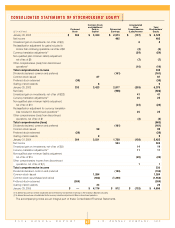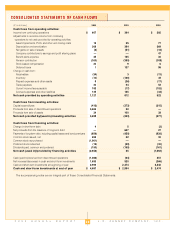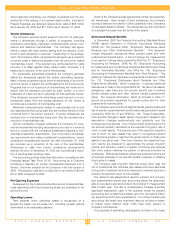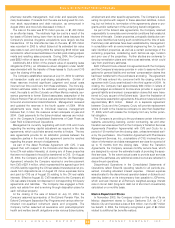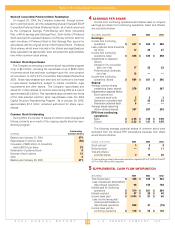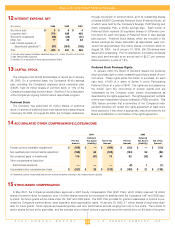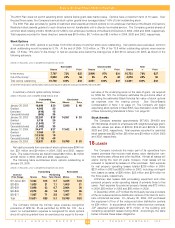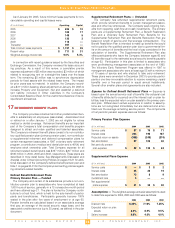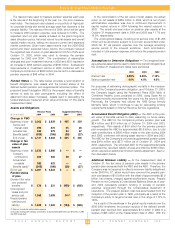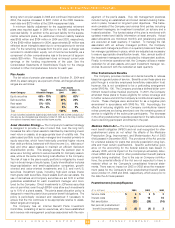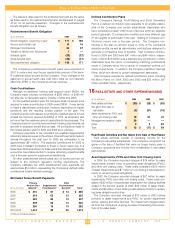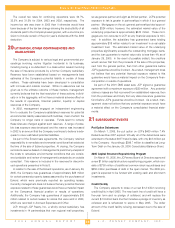JCPenney 2004 Annual Report Download - page 39
Download and view the complete annual report
Please find page 39 of the 2004 JCPenney annual report below. You can navigate through the pages in the report by either clicking on the pages listed below, or by using the keyword search tool below to find specific information within the annual report.
J.C. PENNEY COMPANY, INC.2 004 ANNUAL REPORT
Notes to the Consolidated Financial Statements
37
Non-Cash Investing and Financing Activities
2004
•The Company redeemed all outstanding shares of its Preferred
Stock, all of which were held by the Company’s Savings, Profit
Sharing and Stock Ownership Plan, a 401(k) savings plan.
Each holder of Preferred Stock received 20 equivalent
shares of JCPenney common stock for each one share of
Preferred Stock. The Preferred Stock shares were converted
into approximately nine million common stock shares.
•The Company converted substantially all of JCP’s $650 million 5%
Convertible Subordinated Notes Due 2008 into approximately
22.8 million shares of common stock.
•The Company acquired $18 million of equipment accounted for
as capital leases.
2003
•The Company issued 2.4 million shares of common stock to
fund the 2002 contribution of $47 million to the savings plan.
2002
•The Company issued 2.9 million shares of common stock to
fund the 2001 contribution of $58 million to the savings plan.
•The Company exchanged certain notes and debentures with a
carrying amount of $227 million for new notes recorded at a fair
value of $225 million.
6OTHER ASSETS
($ in millions)
2004 2003
Real estate investments
$ 192 $ 169
Leveraged lease investments
139 134
Capitalized software, net
99 97
Goodwill - Renner
43 42
Debt issuance costs, net
31 52
Other
20 27
Total
$ 524 $ 521
7ACCRUED EXPENSES AND OTHER
($ in millions)
2004 2003
Accrued salaries, vacation and bonus
$ 443 $ 409
Reserves for discontinued operations
221 ––
Customer gift cards/certificates
207 193
Taxes other than income
125 120
Interest payable
107 132
Income taxes payable
79 ––
Advertising payables
78 79
Current portion of workers’ compensation
and general liability insurance
68 63
Funds due for common stock repurchases
51 ––
Common dividends payable
35 35
Other(1)
352 353
Total
$ 1,766 $ 1,384
(1) Other includes various components that are individually insignificant such as general accrued expens-
es related to operations and fixed asset accruals.
8OTHER LIABILITIES
($ in millions)
2004 2003
Retirement benefit plan liabilities
$ 634 $ 652
Long-term portion of workers’ compensation
and general liability insurance
157 141
Reserves for discontinued operations
114 ––
Developer/tenant allowances
111 ––
Other
26 11
Total
$ 1,042 $ 804
9FAIR VALUE OF FINANCIAL INSTRUMENTS
The following methods and assumptions were used in estimating
the fair values of financial instruments:
Cash and Short-Term Investments
The carrying amount approximates fair value because of the
short maturity of these instruments.
Short-Term and Long-Term Debt
Carrying value approximates fair value for short-term debt. The
fair value of long-term debt, excluding equipment financing, capi-
tal leases and other is estimated by obtaining quotes from brokers
or is based on current rates offered for similar debt. At January 29,
2005, long-term debt excluding equipment financing, capital leas-
es and other, had a carrying value of $3.9 billion and a fair value of
$4.3 billion. At January 31, 2004, long-term debt excluding equip-
ment financing, capital leases and other, had a carrying value of
$5.3 billion and a fair value of $5.9 billion.
Concentrations of Credit Risk
The Company has no significant concentrations of credit risk.
10 SHORT-TERM DEBT
The Company’s Brazilian subsidiary, Renner, had short-term
debt outstanding of $22 million at January 29, 2005 and $18 million
at January 31, 2004.
Credit Facility
The Company has a $1.5 billion revolving bank line of credit
(credit facility) with a syndicate of banks with JPMorgan Chase
Bank as administrative agent, which is scheduled to expire in May
2005. The $1.5 billion credit facility is available for general corpo-
rate purposes, including the issuance of letters of credit. Any
indebtedness incurred by the Company under the credit facility
is collateralized by all eligible Department Stores and
Catalog/Internet domestic inventory, as defined in the credit facili-
ty agreement. The security interest can be released as perform-
ance improvements are achieved and credit ratings by the rating
agencies improve. Pricing is tiered based on the corporate credit
ratings for the Company by Moody’s and Standard & Poor’s.
Obligations under the credit facility are guaranteed by J. C. Penney
Company, Inc. and JCP Real Estate Holdings, Inc., which is a whol-
ly owned subsidiary of the Company. No borrowings, other than
the issuance of standby and import letters of credit, which totaled
$153 million as of the end of 2004, have been made under this
credit facility.
Under the $1.5 billion credit facility, the Company is required to
maintain an asset coverage ratio, defined as eligible inventory to
total revolving credit exposure, of at least 1.75 to 1.0. Given that
there were no borrowings other than the issuance of letters of cred-
it, this ratio was 20.3 to 1.0 at year-end 2004, far exceeding the
requirement. Additionally, the credit facility includes a financial
performance covenant, which consists of a maximum ratio of total
debt to consolidated EBITDA (leverage ratio, as defined in the
credit agreement), as measured on a trailing four-quarters basis,


